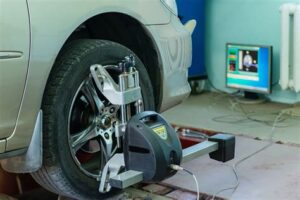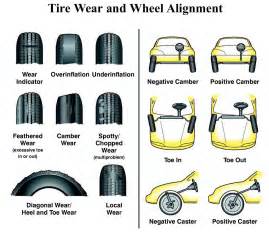Discover the causes of uneven tire wear and vehicle handling issues, including pulling, crooked steering, vibrations, and squealing tires. Learn how to fix them!When it comes to maintaining your vehicle, ensuring proper wheel alignment is crucial for a smooth and safe driving experience. Misalignment can lead to a range of issues that not only affect your car’s handling but also wear down your tires faster and reduce fuel efficiency. But how do you know if your car needs alignment? In this blog post, we will explore key indicators that signal misalignment, including uneven tire wear, your vehicle pulling to one side, a crooked steering wheel, vibrations felt in the steering wheel, and even the telltale sound of squealing tires. By being vigilant about these signs, you can keep your car in optimal condition and save yourself from costly repairs down the road. Let’s dive into these warning signs and help you diagnose alignment issues before they become a major problem.
Uneven Tire Wear
One of the most noticeable signs that your car needs alignment is uneven tire wear. When your vehicle is properly aligned, all four tires wear evenly. However, when misalignment occurs, it can cause your tires to wear more on one side than the other. Look for areas that seem to have more tread loss, as this may be a clear indicator of a need for alignment.
Regularly checking your tire tread can help you catch this problem early. If you notice different wear patterns, such as cupping or scalloping, it is essential to have your vehicle examined by a professional. Ignoring this issue can lead to reduced tire lifespan and may compromise your vehicle’s overall safety.
A good rule of thumb is to inspect your tires at least once a month, especially if you notice your vehicle pulling to one side or if the steering wheel feels off-center. Maintaining proper alignment not only extends the life of your tires but also improves fuel efficiency, providing you with greater savings in the long run.
Vehicle Pulls to One Side
One of the most common signs that your car needs alignment is when it pulls to one side. This can be not only annoying but also dangerous, as it affects your ability to steer correctly. When your vehicle consistently drifts either to the left or right, it indicates that the wheels are not aligned properly, leading to uneven tire wear and compromised safety.
Several factors can cause your vehicle to pull to one side. These include hitting potholes, driving over curbs, or simply the natural wear and tear that comes with using your vehicle. It’s essential to pay attention to these symptoms to prevent more severe issues and maintain the overall health of your car.
If you notice your vehicle pulling to one side, it’s crucial to get a professional alignment service as soon as possible. Ignoring this issue could lead to further complications, including increased tire wear, which can result in the need for costly replacements. Regular maintenance, including ensuring proper alignment, helps you enjoy a smoother, safer ride.
Crooked Steering Wheel
A crooked steering wheel is often a clear indicator that your vehicle may be in need of an alignment. When your steering wheel is not centered while driving straight, it can be both frustrating and unsafe. This issue usually stems from misalignment, which affects the angle of your vehicle’s wheels. Driving with a crooked steering wheel can not only lead to increased tire wear but can also cause handling problems that may compromise your safety on the road.
There are several reasons why a crooked steering wheel may occur. These include hitting a pothole, curbing, or a previous improper alignment. To determine if your steering wheel’s angle is off, try driving down a straight road. If your steering wheel is tilted to one side, it indicates that your wheels are not aligned correctly. Many drivers overlook this sign, but addressing it promptly can save you from more serious issues down the line.
If you notice a crooked steering wheel, it is recommended to have your vehicle inspected by a professional. They can perform an alignment check and make the necessary adjustments to ensure your vehicle drives straight and true. Ignoring this issue could lead to further complications, including poor fuel efficiency and acceleration issues.
Vibrations in the Steering Wheel
If you are experiencing vibrations in the steering wheel while driving, it could indicate that your vehicle is in need of alignment. These vibrations can range from a subtle shake to a noticeable tremor, and understanding their causes is crucial for your safety and comfort on the road.
One of the primary reasons for vibrations in the steering wheel is a misalignment of the wheels. When the wheels are out of alignment, it can lead to inconsistent tire wear, which may cause vibrations as you drive. Additionally, this misalignment can affect the handling of your vehicle, making it feel unstable and potentially pulling to one side.
Other potential causes of vibrations in your steering wheel may include unbalanced tires, worn suspension components, or issues with your brake system. It’s important to have your vehicle inspected by a professional to determine the exact cause and ensure that proper alignment is restored for a smooth driving experience.
Squealing Tires
If you’ve noticed that your tires are squealing, it’s not just an annoying sound; it may be a sign that your vehicle is in need of an alignment. Squealing often occurs due to uneven wear on the tire surface, which can lead to various handling issues.
Here are some common causes of squealing tires:
- Misalignment – When the wheels are not properly aligned, it can cause the tires to wear unevenly, leading to the tires squealing as they make contact with the road.
- Worn-out Components – Issues with the suspension or steering components can contribute to misalignment and tire wear, causing the tires to squeal.
- Tire Pressure – Incorrect tire pressure, whether too high or too low, can also lead to squealing sounds. Regularly checking the tire pressure is essential for maintaining optimal tire health.
Ignoring the squealing sound can lead to more serious problems, such as decreased handling performance, reduced fuel efficiency, and ultimately, the need for tire replacement. If you hear a persistent squeal, it’s advisable to have your vehicle checked by a professional mechanic to determine whether a wheel alignment is necessary.
Frequently Asked Questions
What are the signs that indicate a car needs alignment?
Common signs include uneven tire wear, the vehicle pulling to one side, a crooked steering wheel when driving straight, and vibrations in the steering wheel.
How often should I check my car’s alignment?
It’s advisable to check your car’s alignment at least once a year or whenever you notice any of the signs mentioned, or after hitting a large pothole or curb.
Can misalignment affect fuel efficiency?
Yes, misalignment can cause increased tire friction and drag, which can lead to lower fuel efficiency.
What is the difference between wheel alignment and wheel balancing?
Wheel alignment deals with adjusting the angles of the wheels so that they are perpendicular to the ground and parallel to each other, while wheel balancing involves equalizing the weight of the tire and wheel assembly to prevent vibrations.
Is a visual inspection enough to determine if my car needs alignment?
While a visual inspection can help identify uneven tire wear, it’s best to have a professional alignment check as they can measure precise angles and detect issues not visible to the naked eye.
How much does it typically cost to get a wheel alignment?
The cost of a wheel alignment can vary widely based on location and vehicle type, but it generally ranges from $50 to $100.
Can I align my car’s wheels myself?
While some basic checks can be done at home, proper wheel alignment requires specialized equipment and expertise, so it’s best to have it done by a professional.





